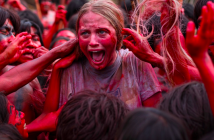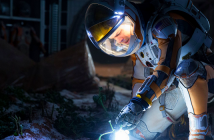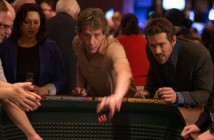Editor’s Notes: The following review is part of our coverage of the 2015 Vancouver International Film Festival. For more information on the festival visit viff.org and follow VIFF on Twitter at @viffest.
Using time-lapse photography, Rappmund channels the topography of the 800 mile Trans-Alaska Pipeline. In doing so, he raises a study of duality, wherein nature and industry are centrally figured. The photography reveals certain distinctions between the environment and man’s use thereof, particularly drawing attention to the living qualities of plants, trees, and rivers in conjunction to the dead world of industry: natural metals formed into unnatural and environmentally questionable forms. Since time-lapse photography skips through time, static or slow moving figures, such as workers and machinery, appear jumpy and unnatural, while the constant movement of nature—wind, water, grass, etc.—appears consistent and alive. Most notably, the pipeline never changes; in spite of long periods of time-lapse, the pipeline and signs remain static, unchanged—dead in the midst of an ever changing landscape.
Topophilia is a worthwhile film if only for the often gorgeous photography. There are some exceptionally arresting images such as a time-lapse shot of glacier ice floating over a water mass. In these cases, the technique of time-lapse brings us something special and otherwise unseen: the ice moves too slowly to be noticed, but through time-lapse we can see the natural course of its movements in mere seconds. There are many other powerful shots, such as that of wind in the trees and an episode of birds flying amidst a blue sky. At other times, time-lapse is a needless exercise; shots of the sky, mountains, and even rivers don’t really show us anything we wouldn’t perceive in real-time. The expansive use of such shots makes the film rather monotonous at times, though always quite impressive.
What is most unusual is the film’s soundtrack, which remains in real time despite the use of time-lapse photography. As a result, there are scenes in the film which either feel incomplete or rhythmically disharmonious and mildly obnoxious. For example, there is a scene where a ship sails quickly onwards in which the sound of the ship is in real time. In another shot, a working man turns a screw abruptly in jumpy time-lapse, while the slow sound of a turning screw is heard. The effect is disorienting and conflicts with the visual rhythm of the film. For others, perhaps it simply feeds into the film’s study of duality, of the natural and unnatural, and of presence and absence. Regardless, Topophilia undoubtedly has much to offer; it is certainly a fascinating example of observational cinema.
Topophilia undoubtedly has much to offer; it is certainly a fascinating example of observational cinema.




